Iraqi government forecasts external debt decrease to $9 billion by 2024
Iraq's government spokesperson has announced a significant decrease in external debts expected for this year. However, the current internal debts are expected to rise considerably due to increased public spending.
Iraqi government spokesperson Basim Al-Awadi announced a notable reduction in the country's external debt. He told Iraq's State News Agency (INA) on Monday that the debt decreased from US$19.729 billion in 2022 to US$15.976 billion in 2023 and projected to reach approximately US$8.9 billion by the end of 2024.
This achievement comes from diligent financial measures implemented by the government. Al-Awadi highlighted the success of initiatives such as halting unproductive borrowing operations, restructuring debts, and directing resources towards strategic projects. These efforts aim to safeguard the Iraqi economy from future uncertainties and ensure sustainable growth.
A significant increase in internal debt flux counters the decline in external debts. Iraq's Central Bank (ICB) reports that internal debt has surged from 38.3 trillion dinars (US$29.4 billion) in 2019 to the current 73.2 trillion dinars (US$56.3 billion).
Furthermore, Al-Awadi emphasised the government's commitment to fostering collaboration with the international community. By prioritising productive borrowing and providing sovereign guarantees for private sector projects, Iraq aims to attract foreign investment and stimulate economic diversification.
Iraq's reliance on oil revenues, which constitute around 96% of its financial income, underscores the importance of economic reforms. The country seeks to utilise the recent surge in oil prices to address financial deficits, reduce debts, and revitalise stalled development projects across vital sectors such as healthcare, education, and infrastructure.
In tandem with debt reduction efforts, Iraq has witnessed a significant uptick in oil exports. Iraqi Oil Minister Hayan Abdulghani confirmed on Friday that Iraq is close to reaching an extraction capacity of up to 5 million barrels of oil per day. Key importers like China and India are contributing to this growth, solidifying Iraq's position as a prominent player in the global oil market.
Mazhar Mohammed Saleh, the financial advisor to the Prime Minister, highlighted Iraq's competitive advantages, including its abundant natural resources and favourable investment climate.
Last month, the International Monetary Fund (IMF) said Iraq in 2024 will witness overall growth, with risks decreasing despite heightened uncertainty.
IMF indicated that non-oil sectors would continue to drive growth, but significant drops in oil prices or extended OPEC+ cuts could impact fiscal and external balances. Escalating regional tensions could disrupt shipping routes and oil infrastructure, affecting production. Domestic security deterioration might halt investment projects. Medium-term projections suggest stable non-oil growth around 2.5%. However, the fiscal deficit is expected to reach 7.6% in 2024, with public debt nearly doubling by 2029, reaching 86%, IMF emphasised.
Iraqi economists caution that excessive inflation, driven by a significant increase in both money supply and demand, poses a major challenge to the country's monetary policy. This inflation adversely affects citizens' purchasing power and undermines economic stability. Furthermore, a budget deficit results from disparities between expenditures and revenues, necessitating additional financing from the central bank or external borrowing.
This trend has been observed in previous years, especially during oil downturns, conflicts with ISIS and significant fluctuations in exchange rates over the past two years. These factors have played an important role in destabilising financial markets and negatively impacting investment and foreign trade.




 Follow the Middle East's top stories in English at The New Arab on Google News
Follow the Middle East's top stories in English at The New Arab on Google News

![A group of Palestinians, foreign and Israeli activists gather to participated in an olive picking event on the land in the town of Battir, which is under threat of confiscation by Israel in Bethlehem, occupied West Bank on 8 November 2024. [Getty]](/sites/default/files/styles/image_330x185/public/2182930803.jpeg?h=199d8c1f&itok=__0LgGsa)
